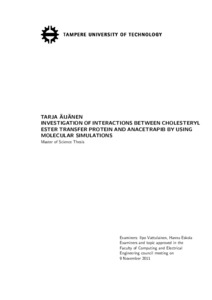Investigation of interactions between cholesteryl ester transfer protein and anacetrapib by using molecular simulations
Äijänen, Tarja (2012)
Äijänen, Tarja
2012
Sähkötekniikan koulutusohjelma
Luonnontieteiden ja ympäristötekniikan tiedekunta - Faculty of Science and Environmental Engineering
This publication is copyrighted. You may download, display and print it for Your own personal use. Commercial use is prohibited.
Hyväksymispäivämäärä
2012-03-07
Julkaisun pysyvä osoite on
https://urn.fi/URN:NBN:fi:tty-201204181092
https://urn.fi/URN:NBN:fi:tty-201204181092
Tiivistelmä
Cardiovascular disease (CVD) is the leading cause of morbidity and mortality in Western societies. The most important cause behind these diseases is a complex condition affecting arterial blood vessels denoted as atherosclerosis. Atherosclerosis is inflicted and restrained by lipoproteins circulating in blood. More specifically, high levels of low density lipoprotein (LDL) have been found to correlate positively and high levels of high density lipoprotein (HDL) inversely with the risk of atherosclerosis.
High LDL levels can be reduced by the use of statins, a strategy that has successively reduced the rate of CVD. However, a significant residual risk still remains since atherosclerosis is a multifactorial disease. Because low HDL levels are an independent risk factor, elevating HDL has become one the most promising strategies in the fight against CVD. Clinical trials have shown that this can be achieved through the inhibition of cholesteryl ester transfer protein (CETP), which transports neutral lipids between different lipoprotein fractions. A novel molecular agent, anacetrapib, has been found to meet these requirements but the precise inhibitory mechanism remains to be elucidated.
In this study the interactions between CETP and anacetrapib were examined using atomistic molecular dynamics simulations. Extensive structural and functional analysis were performed for both particles. The obtained results point towards the important regulatory roles of helix X and phospholipids during the lipid exchange process. These structures were found to experience considerable conformational fluctuations induced by the drug, indicating the possible capability of anacetrapib to inhibit the functions of CETP.
The performed simulations are pioneering and pave the way for further studies, with an objective to extend the scope of computational studies to gain a much deeper understanding concerning the inhibition of CETP. The novel insight could be used in the development of new molecular agents capable of preventing the progression of CVD.
High LDL levels can be reduced by the use of statins, a strategy that has successively reduced the rate of CVD. However, a significant residual risk still remains since atherosclerosis is a multifactorial disease. Because low HDL levels are an independent risk factor, elevating HDL has become one the most promising strategies in the fight against CVD. Clinical trials have shown that this can be achieved through the inhibition of cholesteryl ester transfer protein (CETP), which transports neutral lipids between different lipoprotein fractions. A novel molecular agent, anacetrapib, has been found to meet these requirements but the precise inhibitory mechanism remains to be elucidated.
In this study the interactions between CETP and anacetrapib were examined using atomistic molecular dynamics simulations. Extensive structural and functional analysis were performed for both particles. The obtained results point towards the important regulatory roles of helix X and phospholipids during the lipid exchange process. These structures were found to experience considerable conformational fluctuations induced by the drug, indicating the possible capability of anacetrapib to inhibit the functions of CETP.
The performed simulations are pioneering and pave the way for further studies, with an objective to extend the scope of computational studies to gain a much deeper understanding concerning the inhibition of CETP. The novel insight could be used in the development of new molecular agents capable of preventing the progression of CVD.
